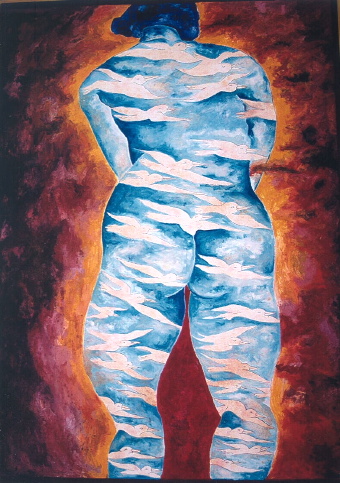The work of Laura Hernández is marked by the presence of duality. Its atmospheres oscillate between the earthly and the sidereal orb in a game of exchanges charged with symbolic codes of high poetic content. Between the reality of this world and its irreality, the corporeal and the spiritual interlink in a combination of contradictory and complementary signs. The union of opposing principals in her work is seen as a metaphor of the fullness of being.
Laura Hernández belongs to the intermediate generation of contemporary Oaxacan artists. When she was five, her family moved to Mexico City, where she studied at "La Esmeralda" (Art School). Images, colors, scents, tastes and personal experiences of her birthplace made a lasting impression in her mind, and over time they bore a strong influence on her painting. She stayed in touch with her origins through her grandparents, at whose ranch she spent her vacations every year. During this time her love of nature and animals flourished, and she discovered a wealth of popular myths and legends that have inspired her imagination. Her passion for ancient civilizations has taken her to explore in depth the Pre Hispanic world, whose cosmogony, based on the concept of duality, has been a constant source of inspiration.
Laura lived between Amsterdam and Paris for almost a decade, with intermittent stays in North Africa, India and South East Asia, specially Cambodia. She absorbed the teachings of age-old cultures, whose philosophical wisdom has enriched her spiritual potential. The pictorial essence of Laura Hernández is based on the universal myths that converge in the eternal question about our existence: the enigmatic relationship between the human being and the surrounding Cosmos.
Her recent work focuses on the representation of female energy by means of emblematic figures that refer to our primitive origins: Virgins and goddesses alternate with Eve, Venus, Nut, Coatlicue and Shakti, sacred and profane Muses who are the Mothers of Time and Daughters of the Cosmos. In the realm of the imagination through which the artist rides with a loose rein, human beings and animals fuse and are confused into a powerful form of nature that embraces and protects them. Her ever pensive characters appear to be in communion with nature and in close complicity with the animal species. They look into their inner depths in order to express, as suggested by the Mesoamerican elders —the Tlamatinime— "a dialog with their own heart".
The quiet murmurings of the voluptuous bodies of fire, mysticism and passion that intermingle in an act of love with Nature reverberate throughout Laura Hernández's paintings. The women appear to wear head-dresses made of birds symbolizing freedom of thought, or else their fleshy lips form the subtle silhouette of a bird that represents poetry in the purest and deepest sense of the word.


Fishes and spiral snails' shells are signs referring to perpetual motion, the interior in the human being, the exterior in the Cosmos. This can be seen in the painting Infinite Movement, in which we see a group of birds intertwined in a powerful spiral whirlwind that seems to have no beginning and no end, like the Universe itself or like the human being that occasionally exceeds his limits.
The spiral is linked to the phases of the moon and is a universal glyph of temporality. This figure, full of symbolic meaning, appears in all cultures: in sum, it represents the repeated rhythms of life, the cyclical nature of evolution. Spiral signs marking the sexual organs found on certain female forms dating back to the Paleolithic era are common. In Generation, Laura Hernández uses the spiral snail as a sexual symbol referring to the vulva, the source of erotic pleasure and of fertility.
Her luxuriant women with their dark skin like burnished mud represent Mother Earth and Venus, the Goddess of Love and queen of all carnal pleasures. The imposing Yael, with her swollen breasts, ample hips and thin waist offers herself openly in the form of a gannet that symbolizes access to the Cosmos, a metaphor of infinite eroticism. Shakti is an example of the fusion of traditions: the Hindu goddess portrayed with indigenous traces evokes the energy of the female figure as a universal symbol. In Oriental mythology, Shakti -an emblematic figure of Nature- represents the active principal of energy, and one of its attributes is precisely to reconcile male and female energy, starting with the Tantrism that suggests that man has a feminine side and vice versa, a concept fully accepted today in Biology and Psychology.
Her pictorial technique deserves special attention. Her palette stands out for its fresh, brilliant colors, dominated by a range of blues symbolizing different atmospheres and different states; indigo blue represents the Cosmos, cobalt blue is associated with time and celestial blue refers to water, the wind and the spirits. Her textures are truly surprising: a thick surface shows through superimposed oils and pigments, applied in a meticulous process; the rich layers of materials evoke the forms and shapes of the earth while the fine glazes she uses, reveal acuatic or heavenly atmospheres.
The art of Laura Hernández is the fusion of myths and cosmogonies, of legends and realities, of libido and earth, of the past in the present in the past all expressed through a kaleidoscopic view that sheds light on both the dark and luminous aspects of the world and the human being. The duality in her painting emphasizes the importance of the union of opposites, of the male and the female, associated with ying and yang, inseparable notions on whose rhythm and alternation the continuity of the Universe depends.